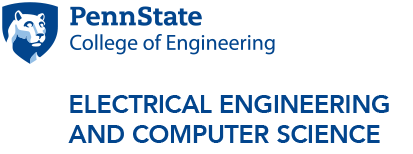Werner receives Outstanding Technical Achievement award from DOTC
6/18/2018
UNIVERSITY PARK, Pa. — Doug Werner, John L. and Genevieve H. McCain Chair Professor of Electrical Engineering, Penn State, recently received an Outstanding Technical Achievement award from the Department of Defense Ordnance Technology Consortium (DOTC) for his project titled, “Metamaterial-Enabled Small Form-Factor Antennas for High-Power Microwave (HPM) Applications.”
“This award recognizes the value of Werner’s technology to the government and success in rapidly moving his prototype closer to a product of service to the nation,” said Penn State Department of Mechanical and Nuclear Engineering’s Eric Boyer, who is a member of the DOTC Executive Committee.
Through the project, funded by the Joint Non-Lethal Weapons Directorate (JNLWD), Werner and his research team developed metamaterials that could withstand very high power — from hundreds of kilowatts to megawatts — for use in directed energy applications.
The advanced metamaterial-enabled antenna technology is much lighter and smaller as well as more versatile and effective than traditional high power microwave antennas. “The new technology solves some key issues and drawbacks in the conventional technology that’s currently used,” explained Werner, who is also director of the Penn State Computational Electromagnetics and Antennas Research Laboratory (CEARL). “If future measurement campaigns are successful, this technology could be transitioned into real-world systems that are used out in the field.”
Micah Gregory, assistant research professor of electrical engineering at Penn State and a key person on the project, accepted the award on Werner’s behalf at the annual National Armaments Consortium (NAC) General Membership Meeting, held in Crystal City, Arlington, Virginia, on April 11.
“The work has been and continues to be a potent validation of the benefits and practical applicability of metamaterials where they were previously thought to have few real-world uses. More specifically, metamaterials were rarely considered for any high power applications due to the tendency toward strong field enhancement in traditional designs which leads to breakdown failure when they are subjected to strong field intensities,” said Gregory. “In spite of this, the ground-breaking research by members of Penn State CEARL has led to several metamaterial prototypes that have been field-tested and proved to have substantial, unrivaled power and field intensity handling. These prototypes have piqued significant interest in the defense community and will likely lead to many more research and development efforts.”
To date, JNLWD has funded more than $8 million for three projects conducted by Werner and his team of researchers.
Werner, who has been a member of Penn State electrical engineering faculty since 1998, has made significant contributions to the field of electromagnetics and optics. He is a Fellow of the IEEE (Institute of Electrical and Electronics Engineers), ACES (Applied Computational Electromagnetics Society), IET (Institution of Engineering Technology), and OSA (The Optical Society). He received a B.S., M.S. and Ph.D. in electrical engineering, as well as an M.A. in mathematics, from Penn State.
The NAC is the industrial/academic component of the DOTC, an enterprise established by the Office of the Secretary of Defense to serve as the focal point for ordnance system technology research and development to address the Department of Defense”s long range science and technology objectives. Penn State is one of 22 academic members of the NAC, and one of 660 members overall.
For Penn State faculty who wish to learn more about DOTC’s science and technology objectives, email YouYou Cheng, director of research administration in the College of Engineering, at yuc33@psu.edu.




